MITS5001 Project Report: Challenges in ERP Implementation in Malaysia
VerifiedAdded on 2022/10/06
|8
|2259
|23
Report
AI Summary
This report, submitted by a student and available on Desklib, investigates the challenges encountered during the implementation of Enterprise Resource Planning (ERP) systems in the public sector of Malaysia. The report highlights the government's push for ERP adoption to improve efficiency and transparency. It discusses various issues, including the complexity of existing working structures, the need for employee adaptation to new systems, lack of skilled personnel, insufficient ICT infrastructure, and budget constraints. The study draws on data collected from accountants in local Malaysian organizations. The report provides recommendations such as selecting the right software, providing proper employee training, and conducting thorough testing. It concludes by emphasizing the need for organizations to address these challenges proactively to mitigate risks and ensure the successful implementation of ERP systems. The report is designed to provide valuable insights into the key factors influencing ERP implementation success and offers practical guidance for organizations seeking to adopt or improve their ERP systems.
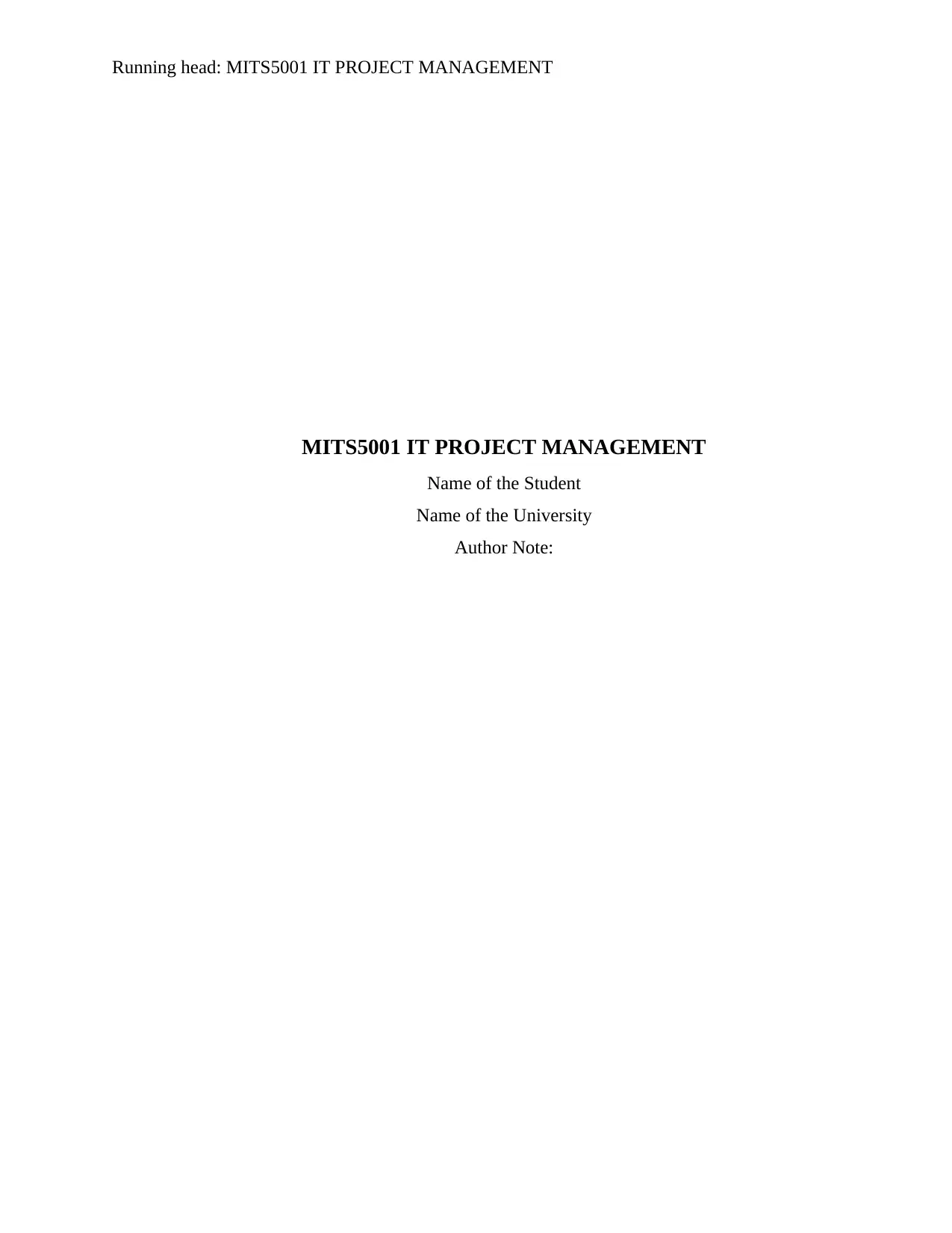
Running head: MITS5001 IT PROJECT MANAGEMENT
MITS5001 IT PROJECT MANAGEMENT
Name of the Student
Name of the University
Author Note:
MITS5001 IT PROJECT MANAGEMENT
Name of the Student
Name of the University
Author Note:
Paraphrase This Document
Need a fresh take? Get an instant paraphrase of this document with our AI Paraphraser
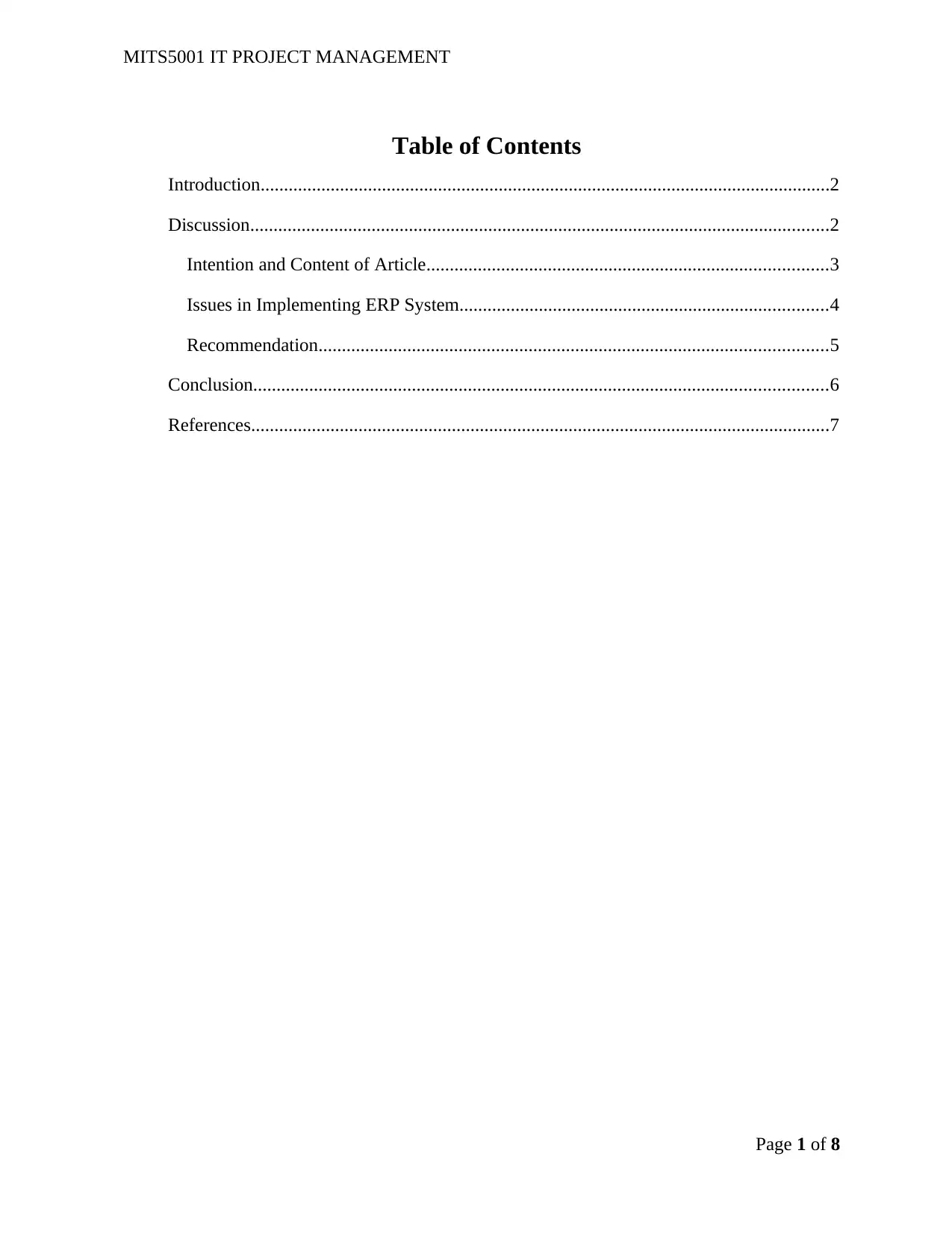
MITS5001 IT PROJECT MANAGEMENT
Table of Contents
Introduction..........................................................................................................................2
Discussion............................................................................................................................2
Intention and Content of Article......................................................................................3
Issues in Implementing ERP System...............................................................................4
Recommendation.............................................................................................................5
Conclusion...........................................................................................................................6
References............................................................................................................................7
Page 1 of 8
Table of Contents
Introduction..........................................................................................................................2
Discussion............................................................................................................................2
Intention and Content of Article......................................................................................3
Issues in Implementing ERP System...............................................................................4
Recommendation.............................................................................................................5
Conclusion...........................................................................................................................6
References............................................................................................................................7
Page 1 of 8
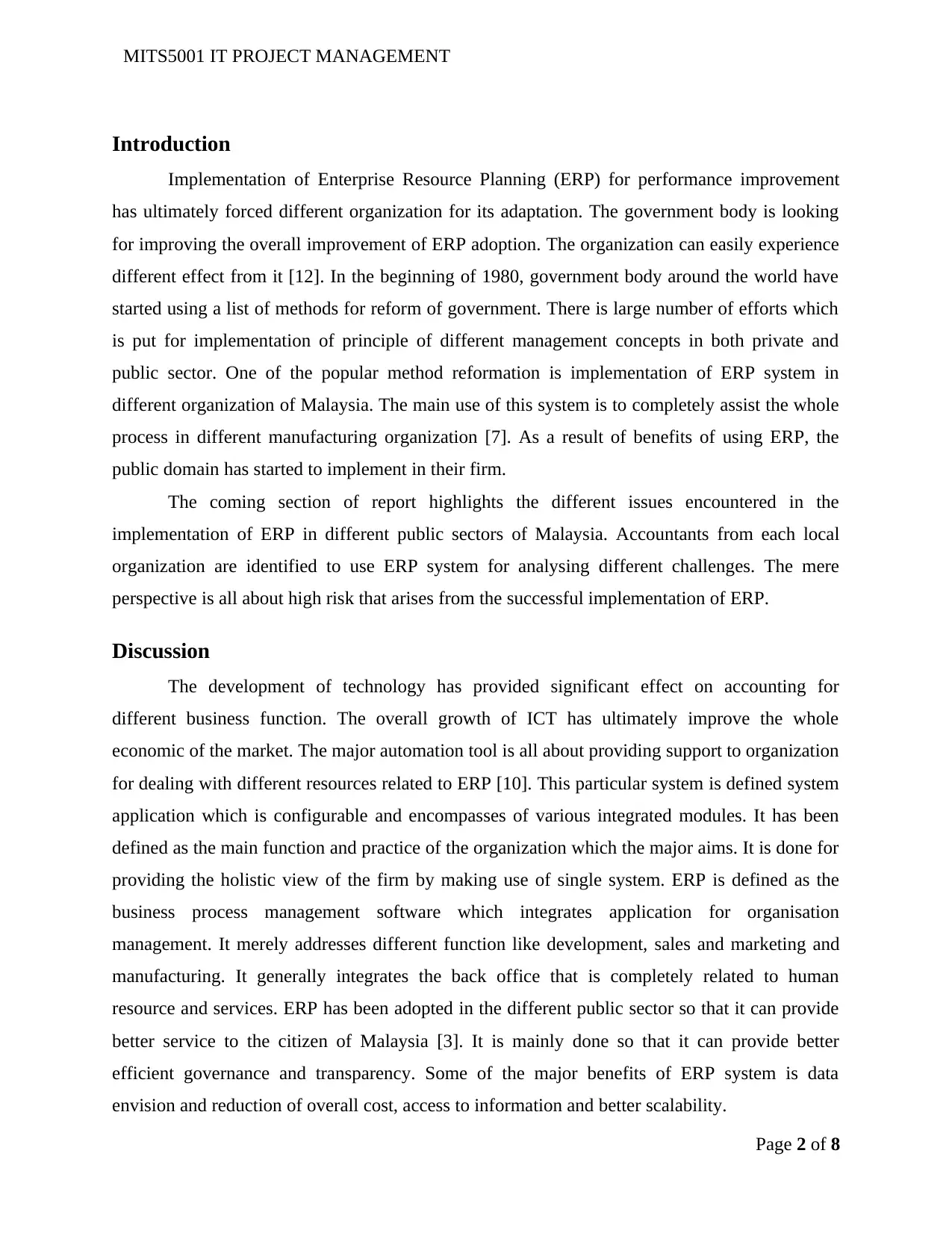
MITS5001 IT PROJECT MANAGEMENT
Introduction
Implementation of Enterprise Resource Planning (ERP) for performance improvement
has ultimately forced different organization for its adaptation. The government body is looking
for improving the overall improvement of ERP adoption. The organization can easily experience
different effect from it [12]. In the beginning of 1980, government body around the world have
started using a list of methods for reform of government. There is large number of efforts which
is put for implementation of principle of different management concepts in both private and
public sector. One of the popular method reformation is implementation of ERP system in
different organization of Malaysia. The main use of this system is to completely assist the whole
process in different manufacturing organization [7]. As a result of benefits of using ERP, the
public domain has started to implement in their firm.
The coming section of report highlights the different issues encountered in the
implementation of ERP in different public sectors of Malaysia. Accountants from each local
organization are identified to use ERP system for analysing different challenges. The mere
perspective is all about high risk that arises from the successful implementation of ERP.
Discussion
The development of technology has provided significant effect on accounting for
different business function. The overall growth of ICT has ultimately improve the whole
economic of the market. The major automation tool is all about providing support to organization
for dealing with different resources related to ERP [10]. This particular system is defined system
application which is configurable and encompasses of various integrated modules. It has been
defined as the main function and practice of the organization which the major aims. It is done for
providing the holistic view of the firm by making use of single system. ERP is defined as the
business process management software which integrates application for organisation
management. It merely addresses different function like development, sales and marketing and
manufacturing. It generally integrates the back office that is completely related to human
resource and services. ERP has been adopted in the different public sector so that it can provide
better service to the citizen of Malaysia [3]. It is mainly done so that it can provide better
efficient governance and transparency. Some of the major benefits of ERP system is data
envision and reduction of overall cost, access to information and better scalability.
Page 2 of 8
Introduction
Implementation of Enterprise Resource Planning (ERP) for performance improvement
has ultimately forced different organization for its adaptation. The government body is looking
for improving the overall improvement of ERP adoption. The organization can easily experience
different effect from it [12]. In the beginning of 1980, government body around the world have
started using a list of methods for reform of government. There is large number of efforts which
is put for implementation of principle of different management concepts in both private and
public sector. One of the popular method reformation is implementation of ERP system in
different organization of Malaysia. The main use of this system is to completely assist the whole
process in different manufacturing organization [7]. As a result of benefits of using ERP, the
public domain has started to implement in their firm.
The coming section of report highlights the different issues encountered in the
implementation of ERP in different public sectors of Malaysia. Accountants from each local
organization are identified to use ERP system for analysing different challenges. The mere
perspective is all about high risk that arises from the successful implementation of ERP.
Discussion
The development of technology has provided significant effect on accounting for
different business function. The overall growth of ICT has ultimately improve the whole
economic of the market. The major automation tool is all about providing support to organization
for dealing with different resources related to ERP [10]. This particular system is defined system
application which is configurable and encompasses of various integrated modules. It has been
defined as the main function and practice of the organization which the major aims. It is done for
providing the holistic view of the firm by making use of single system. ERP is defined as the
business process management software which integrates application for organisation
management. It merely addresses different function like development, sales and marketing and
manufacturing. It generally integrates the back office that is completely related to human
resource and services. ERP has been adopted in the different public sector so that it can provide
better service to the citizen of Malaysia [3]. It is mainly done so that it can provide better
efficient governance and transparency. Some of the major benefits of ERP system is data
envision and reduction of overall cost, access to information and better scalability.
Page 2 of 8
⊘ This is a preview!⊘
Do you want full access?
Subscribe today to unlock all pages.

Trusted by 1+ million students worldwide
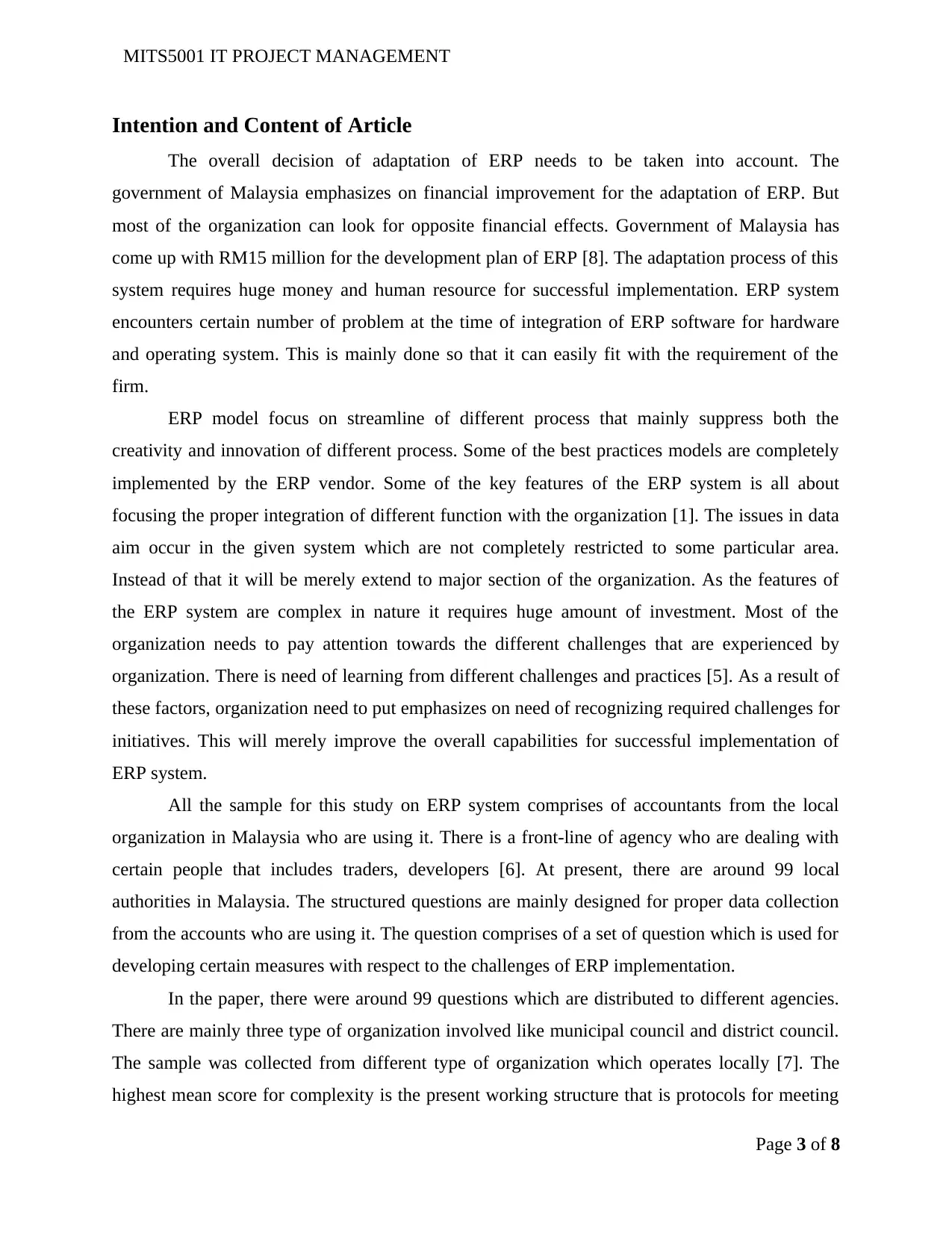
MITS5001 IT PROJECT MANAGEMENT
Intention and Content of Article
The overall decision of adaptation of ERP needs to be taken into account. The
government of Malaysia emphasizes on financial improvement for the adaptation of ERP. But
most of the organization can look for opposite financial effects. Government of Malaysia has
come up with RM15 million for the development plan of ERP [8]. The adaptation process of this
system requires huge money and human resource for successful implementation. ERP system
encounters certain number of problem at the time of integration of ERP software for hardware
and operating system. This is mainly done so that it can easily fit with the requirement of the
firm.
ERP model focus on streamline of different process that mainly suppress both the
creativity and innovation of different process. Some of the best practices models are completely
implemented by the ERP vendor. Some of the key features of the ERP system is all about
focusing the proper integration of different function with the organization [1]. The issues in data
aim occur in the given system which are not completely restricted to some particular area.
Instead of that it will be merely extend to major section of the organization. As the features of
the ERP system are complex in nature it requires huge amount of investment. Most of the
organization needs to pay attention towards the different challenges that are experienced by
organization. There is need of learning from different challenges and practices [5]. As a result of
these factors, organization need to put emphasizes on need of recognizing required challenges for
initiatives. This will merely improve the overall capabilities for successful implementation of
ERP system.
All the sample for this study on ERP system comprises of accountants from the local
organization in Malaysia who are using it. There is a front-line of agency who are dealing with
certain people that includes traders, developers [6]. At present, there are around 99 local
authorities in Malaysia. The structured questions are mainly designed for proper data collection
from the accounts who are using it. The question comprises of a set of question which is used for
developing certain measures with respect to the challenges of ERP implementation.
In the paper, there were around 99 questions which are distributed to different agencies.
There are mainly three type of organization involved like municipal council and district council.
The sample was collected from different type of organization which operates locally [7]. The
highest mean score for complexity is the present working structure that is protocols for meeting
Page 3 of 8
Intention and Content of Article
The overall decision of adaptation of ERP needs to be taken into account. The
government of Malaysia emphasizes on financial improvement for the adaptation of ERP. But
most of the organization can look for opposite financial effects. Government of Malaysia has
come up with RM15 million for the development plan of ERP [8]. The adaptation process of this
system requires huge money and human resource for successful implementation. ERP system
encounters certain number of problem at the time of integration of ERP software for hardware
and operating system. This is mainly done so that it can easily fit with the requirement of the
firm.
ERP model focus on streamline of different process that mainly suppress both the
creativity and innovation of different process. Some of the best practices models are completely
implemented by the ERP vendor. Some of the key features of the ERP system is all about
focusing the proper integration of different function with the organization [1]. The issues in data
aim occur in the given system which are not completely restricted to some particular area.
Instead of that it will be merely extend to major section of the organization. As the features of
the ERP system are complex in nature it requires huge amount of investment. Most of the
organization needs to pay attention towards the different challenges that are experienced by
organization. There is need of learning from different challenges and practices [5]. As a result of
these factors, organization need to put emphasizes on need of recognizing required challenges for
initiatives. This will merely improve the overall capabilities for successful implementation of
ERP system.
All the sample for this study on ERP system comprises of accountants from the local
organization in Malaysia who are using it. There is a front-line of agency who are dealing with
certain people that includes traders, developers [6]. At present, there are around 99 local
authorities in Malaysia. The structured questions are mainly designed for proper data collection
from the accounts who are using it. The question comprises of a set of question which is used for
developing certain measures with respect to the challenges of ERP implementation.
In the paper, there were around 99 questions which are distributed to different agencies.
There are mainly three type of organization involved like municipal council and district council.
The sample was collected from different type of organization which operates locally [7]. The
highest mean score for complexity is the present working structure that is protocols for meeting
Page 3 of 8
Paraphrase This Document
Need a fresh take? Get an instant paraphrase of this document with our AI Paraphraser
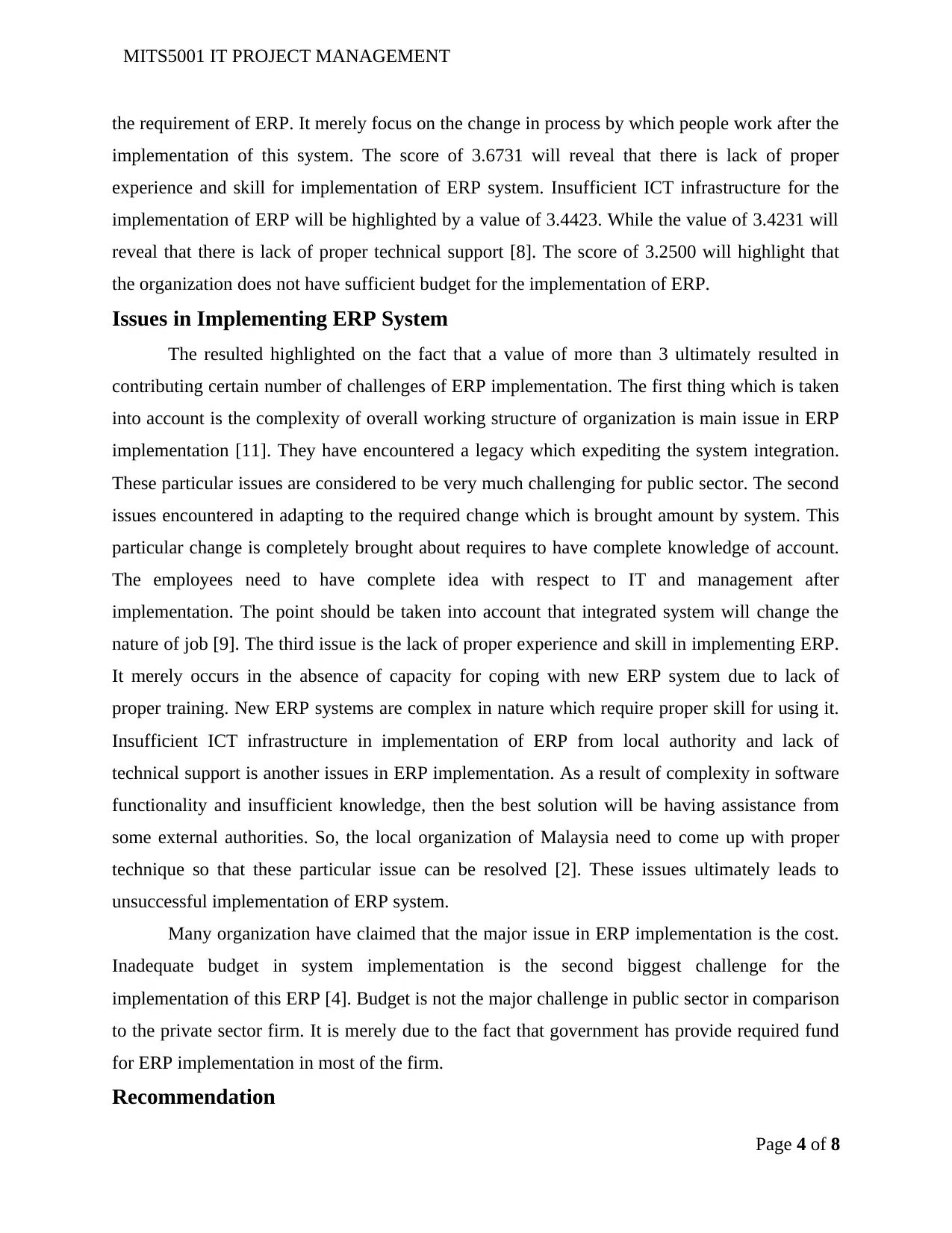
MITS5001 IT PROJECT MANAGEMENT
the requirement of ERP. It merely focus on the change in process by which people work after the
implementation of this system. The score of 3.6731 will reveal that there is lack of proper
experience and skill for implementation of ERP system. Insufficient ICT infrastructure for the
implementation of ERP will be highlighted by a value of 3.4423. While the value of 3.4231 will
reveal that there is lack of proper technical support [8]. The score of 3.2500 will highlight that
the organization does not have sufficient budget for the implementation of ERP.
Issues in Implementing ERP System
The resulted highlighted on the fact that a value of more than 3 ultimately resulted in
contributing certain number of challenges of ERP implementation. The first thing which is taken
into account is the complexity of overall working structure of organization is main issue in ERP
implementation [11]. They have encountered a legacy which expediting the system integration.
These particular issues are considered to be very much challenging for public sector. The second
issues encountered in adapting to the required change which is brought amount by system. This
particular change is completely brought about requires to have complete knowledge of account.
The employees need to have complete idea with respect to IT and management after
implementation. The point should be taken into account that integrated system will change the
nature of job [9]. The third issue is the lack of proper experience and skill in implementing ERP.
It merely occurs in the absence of capacity for coping with new ERP system due to lack of
proper training. New ERP systems are complex in nature which require proper skill for using it.
Insufficient ICT infrastructure in implementation of ERP from local authority and lack of
technical support is another issues in ERP implementation. As a result of complexity in software
functionality and insufficient knowledge, then the best solution will be having assistance from
some external authorities. So, the local organization of Malaysia need to come up with proper
technique so that these particular issue can be resolved [2]. These issues ultimately leads to
unsuccessful implementation of ERP system.
Many organization have claimed that the major issue in ERP implementation is the cost.
Inadequate budget in system implementation is the second biggest challenge for the
implementation of this ERP [4]. Budget is not the major challenge in public sector in comparison
to the private sector firm. It is merely due to the fact that government has provide required fund
for ERP implementation in most of the firm.
Recommendation
Page 4 of 8
the requirement of ERP. It merely focus on the change in process by which people work after the
implementation of this system. The score of 3.6731 will reveal that there is lack of proper
experience and skill for implementation of ERP system. Insufficient ICT infrastructure for the
implementation of ERP will be highlighted by a value of 3.4423. While the value of 3.4231 will
reveal that there is lack of proper technical support [8]. The score of 3.2500 will highlight that
the organization does not have sufficient budget for the implementation of ERP.
Issues in Implementing ERP System
The resulted highlighted on the fact that a value of more than 3 ultimately resulted in
contributing certain number of challenges of ERP implementation. The first thing which is taken
into account is the complexity of overall working structure of organization is main issue in ERP
implementation [11]. They have encountered a legacy which expediting the system integration.
These particular issues are considered to be very much challenging for public sector. The second
issues encountered in adapting to the required change which is brought amount by system. This
particular change is completely brought about requires to have complete knowledge of account.
The employees need to have complete idea with respect to IT and management after
implementation. The point should be taken into account that integrated system will change the
nature of job [9]. The third issue is the lack of proper experience and skill in implementing ERP.
It merely occurs in the absence of capacity for coping with new ERP system due to lack of
proper training. New ERP systems are complex in nature which require proper skill for using it.
Insufficient ICT infrastructure in implementation of ERP from local authority and lack of
technical support is another issues in ERP implementation. As a result of complexity in software
functionality and insufficient knowledge, then the best solution will be having assistance from
some external authorities. So, the local organization of Malaysia need to come up with proper
technique so that these particular issue can be resolved [2]. These issues ultimately leads to
unsuccessful implementation of ERP system.
Many organization have claimed that the major issue in ERP implementation is the cost.
Inadequate budget in system implementation is the second biggest challenge for the
implementation of this ERP [4]. Budget is not the major challenge in public sector in comparison
to the private sector firm. It is merely due to the fact that government has provide required fund
for ERP implementation in most of the firm.
Recommendation
Page 4 of 8
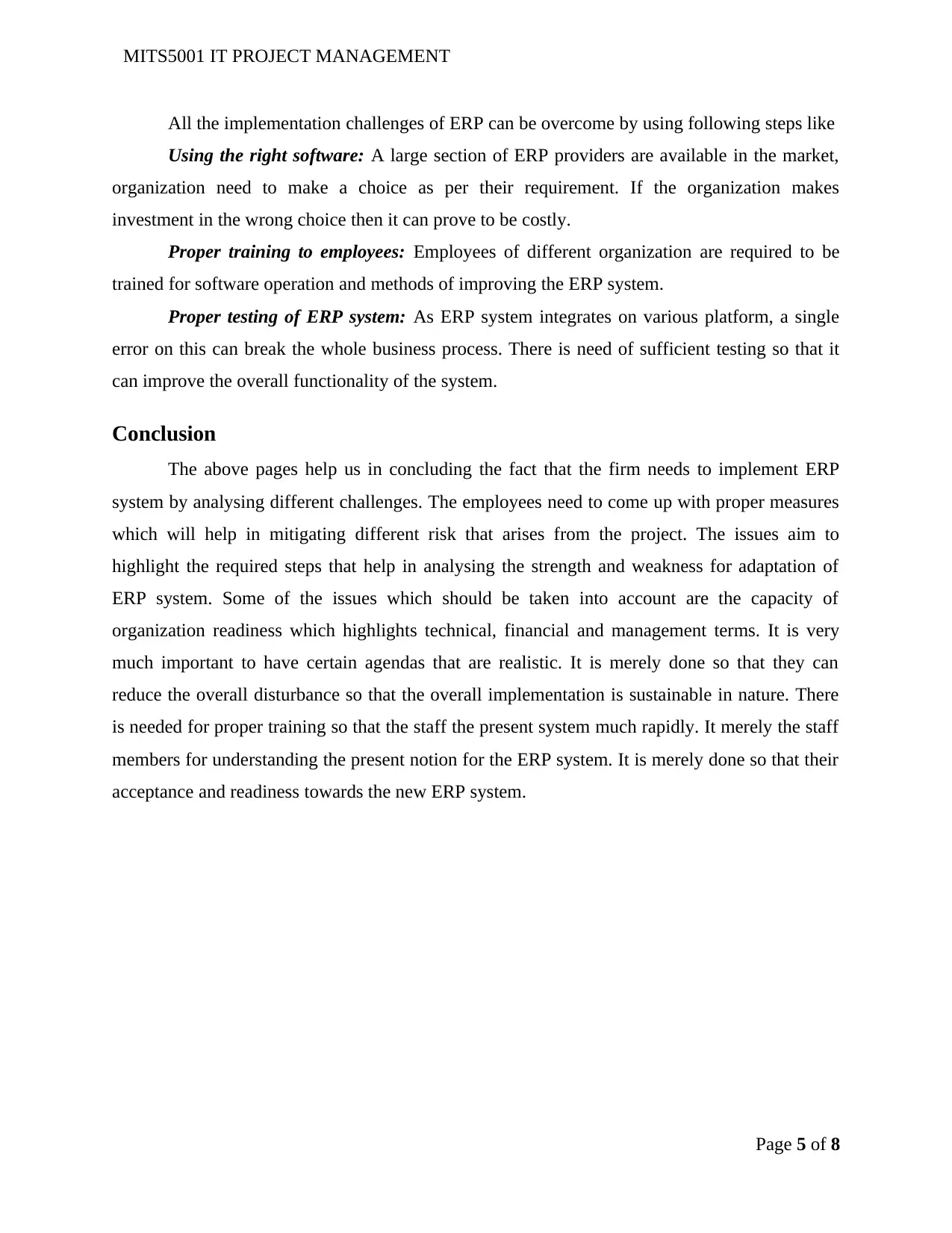
MITS5001 IT PROJECT MANAGEMENT
All the implementation challenges of ERP can be overcome by using following steps like
Using the right software: A large section of ERP providers are available in the market,
organization need to make a choice as per their requirement. If the organization makes
investment in the wrong choice then it can prove to be costly.
Proper training to employees: Employees of different organization are required to be
trained for software operation and methods of improving the ERP system.
Proper testing of ERP system: As ERP system integrates on various platform, a single
error on this can break the whole business process. There is need of sufficient testing so that it
can improve the overall functionality of the system.
Conclusion
The above pages help us in concluding the fact that the firm needs to implement ERP
system by analysing different challenges. The employees need to come up with proper measures
which will help in mitigating different risk that arises from the project. The issues aim to
highlight the required steps that help in analysing the strength and weakness for adaptation of
ERP system. Some of the issues which should be taken into account are the capacity of
organization readiness which highlights technical, financial and management terms. It is very
much important to have certain agendas that are realistic. It is merely done so that they can
reduce the overall disturbance so that the overall implementation is sustainable in nature. There
is needed for proper training so that the staff the present system much rapidly. It merely the staff
members for understanding the present notion for the ERP system. It is merely done so that their
acceptance and readiness towards the new ERP system.
Page 5 of 8
All the implementation challenges of ERP can be overcome by using following steps like
Using the right software: A large section of ERP providers are available in the market,
organization need to make a choice as per their requirement. If the organization makes
investment in the wrong choice then it can prove to be costly.
Proper training to employees: Employees of different organization are required to be
trained for software operation and methods of improving the ERP system.
Proper testing of ERP system: As ERP system integrates on various platform, a single
error on this can break the whole business process. There is need of sufficient testing so that it
can improve the overall functionality of the system.
Conclusion
The above pages help us in concluding the fact that the firm needs to implement ERP
system by analysing different challenges. The employees need to come up with proper measures
which will help in mitigating different risk that arises from the project. The issues aim to
highlight the required steps that help in analysing the strength and weakness for adaptation of
ERP system. Some of the issues which should be taken into account are the capacity of
organization readiness which highlights technical, financial and management terms. It is very
much important to have certain agendas that are realistic. It is merely done so that they can
reduce the overall disturbance so that the overall implementation is sustainable in nature. There
is needed for proper training so that the staff the present system much rapidly. It merely the staff
members for understanding the present notion for the ERP system. It is merely done so that their
acceptance and readiness towards the new ERP system.
Page 5 of 8
⊘ This is a preview!⊘
Do you want full access?
Subscribe today to unlock all pages.

Trusted by 1+ million students worldwide
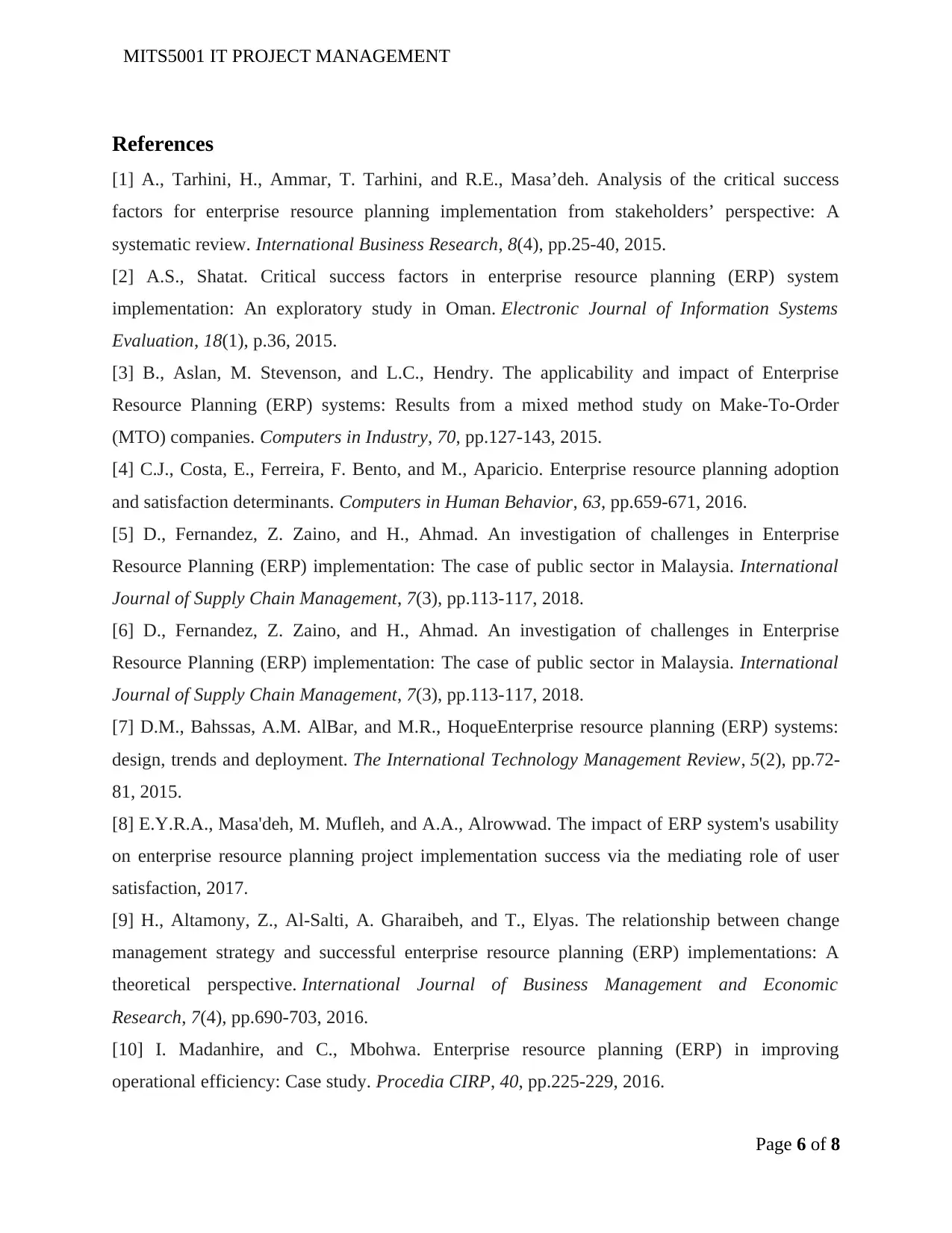
MITS5001 IT PROJECT MANAGEMENT
References
[1] A., Tarhini, H., Ammar, T. Tarhini, and R.E., Masa’deh. Analysis of the critical success
factors for enterprise resource planning implementation from stakeholders’ perspective: A
systematic review. International Business Research, 8(4), pp.25-40, 2015.
[2] A.S., Shatat. Critical success factors in enterprise resource planning (ERP) system
implementation: An exploratory study in Oman. Electronic Journal of Information Systems
Evaluation, 18(1), p.36, 2015.
[3] B., Aslan, M. Stevenson, and L.C., Hendry. The applicability and impact of Enterprise
Resource Planning (ERP) systems: Results from a mixed method study on Make-To-Order
(MTO) companies. Computers in Industry, 70, pp.127-143, 2015.
[4] C.J., Costa, E., Ferreira, F. Bento, and M., Aparicio. Enterprise resource planning adoption
and satisfaction determinants. Computers in Human Behavior, 63, pp.659-671, 2016.
[5] D., Fernandez, Z. Zaino, and H., Ahmad. An investigation of challenges in Enterprise
Resource Planning (ERP) implementation: The case of public sector in Malaysia. International
Journal of Supply Chain Management, 7(3), pp.113-117, 2018.
[6] D., Fernandez, Z. Zaino, and H., Ahmad. An investigation of challenges in Enterprise
Resource Planning (ERP) implementation: The case of public sector in Malaysia. International
Journal of Supply Chain Management, 7(3), pp.113-117, 2018.
[7] D.M., Bahssas, A.M. AlBar, and M.R., HoqueEnterprise resource planning (ERP) systems:
design, trends and deployment. The International Technology Management Review, 5(2), pp.72-
81, 2015.
[8] E.Y.R.A., Masa'deh, M. Mufleh, and A.A., Alrowwad. The impact of ERP system's usability
on enterprise resource planning project implementation success via the mediating role of user
satisfaction, 2017.
[9] H., Altamony, Z., Al-Salti, A. Gharaibeh, and T., Elyas. The relationship between change
management strategy and successful enterprise resource planning (ERP) implementations: A
theoretical perspective. International Journal of Business Management and Economic
Research, 7(4), pp.690-703, 2016.
[10] I. Madanhire, and C., Mbohwa. Enterprise resource planning (ERP) in improving
operational efficiency: Case study. Procedia CIRP, 40, pp.225-229, 2016.
Page 6 of 8
References
[1] A., Tarhini, H., Ammar, T. Tarhini, and R.E., Masa’deh. Analysis of the critical success
factors for enterprise resource planning implementation from stakeholders’ perspective: A
systematic review. International Business Research, 8(4), pp.25-40, 2015.
[2] A.S., Shatat. Critical success factors in enterprise resource planning (ERP) system
implementation: An exploratory study in Oman. Electronic Journal of Information Systems
Evaluation, 18(1), p.36, 2015.
[3] B., Aslan, M. Stevenson, and L.C., Hendry. The applicability and impact of Enterprise
Resource Planning (ERP) systems: Results from a mixed method study on Make-To-Order
(MTO) companies. Computers in Industry, 70, pp.127-143, 2015.
[4] C.J., Costa, E., Ferreira, F. Bento, and M., Aparicio. Enterprise resource planning adoption
and satisfaction determinants. Computers in Human Behavior, 63, pp.659-671, 2016.
[5] D., Fernandez, Z. Zaino, and H., Ahmad. An investigation of challenges in Enterprise
Resource Planning (ERP) implementation: The case of public sector in Malaysia. International
Journal of Supply Chain Management, 7(3), pp.113-117, 2018.
[6] D., Fernandez, Z. Zaino, and H., Ahmad. An investigation of challenges in Enterprise
Resource Planning (ERP) implementation: The case of public sector in Malaysia. International
Journal of Supply Chain Management, 7(3), pp.113-117, 2018.
[7] D.M., Bahssas, A.M. AlBar, and M.R., HoqueEnterprise resource planning (ERP) systems:
design, trends and deployment. The International Technology Management Review, 5(2), pp.72-
81, 2015.
[8] E.Y.R.A., Masa'deh, M. Mufleh, and A.A., Alrowwad. The impact of ERP system's usability
on enterprise resource planning project implementation success via the mediating role of user
satisfaction, 2017.
[9] H., Altamony, Z., Al-Salti, A. Gharaibeh, and T., Elyas. The relationship between change
management strategy and successful enterprise resource planning (ERP) implementations: A
theoretical perspective. International Journal of Business Management and Economic
Research, 7(4), pp.690-703, 2016.
[10] I. Madanhire, and C., Mbohwa. Enterprise resource planning (ERP) in improving
operational efficiency: Case study. Procedia CIRP, 40, pp.225-229, 2016.
Page 6 of 8
Paraphrase This Document
Need a fresh take? Get an instant paraphrase of this document with our AI Paraphraser
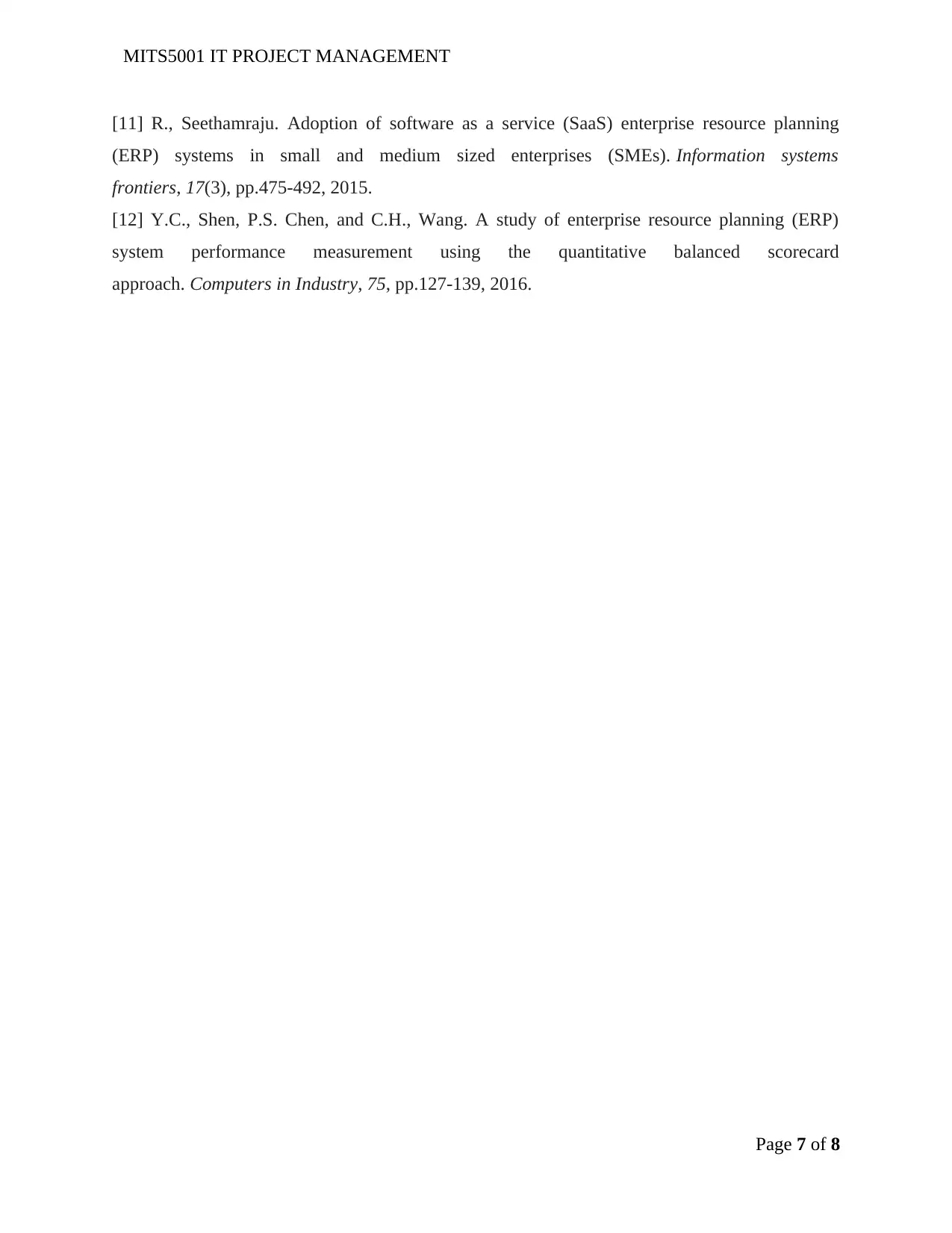
MITS5001 IT PROJECT MANAGEMENT
[11] R., Seethamraju. Adoption of software as a service (SaaS) enterprise resource planning
(ERP) systems in small and medium sized enterprises (SMEs). Information systems
frontiers, 17(3), pp.475-492, 2015.
[12] Y.C., Shen, P.S. Chen, and C.H., Wang. A study of enterprise resource planning (ERP)
system performance measurement using the quantitative balanced scorecard
approach. Computers in Industry, 75, pp.127-139, 2016.
Page 7 of 8
[11] R., Seethamraju. Adoption of software as a service (SaaS) enterprise resource planning
(ERP) systems in small and medium sized enterprises (SMEs). Information systems
frontiers, 17(3), pp.475-492, 2015.
[12] Y.C., Shen, P.S. Chen, and C.H., Wang. A study of enterprise resource planning (ERP)
system performance measurement using the quantitative balanced scorecard
approach. Computers in Industry, 75, pp.127-139, 2016.
Page 7 of 8
1 out of 8
Related Documents
Your All-in-One AI-Powered Toolkit for Academic Success.
+13062052269
info@desklib.com
Available 24*7 on WhatsApp / Email
![[object Object]](/_next/static/media/star-bottom.7253800d.svg)
Unlock your academic potential
Copyright © 2020–2025 A2Z Services. All Rights Reserved. Developed and managed by ZUCOL.





